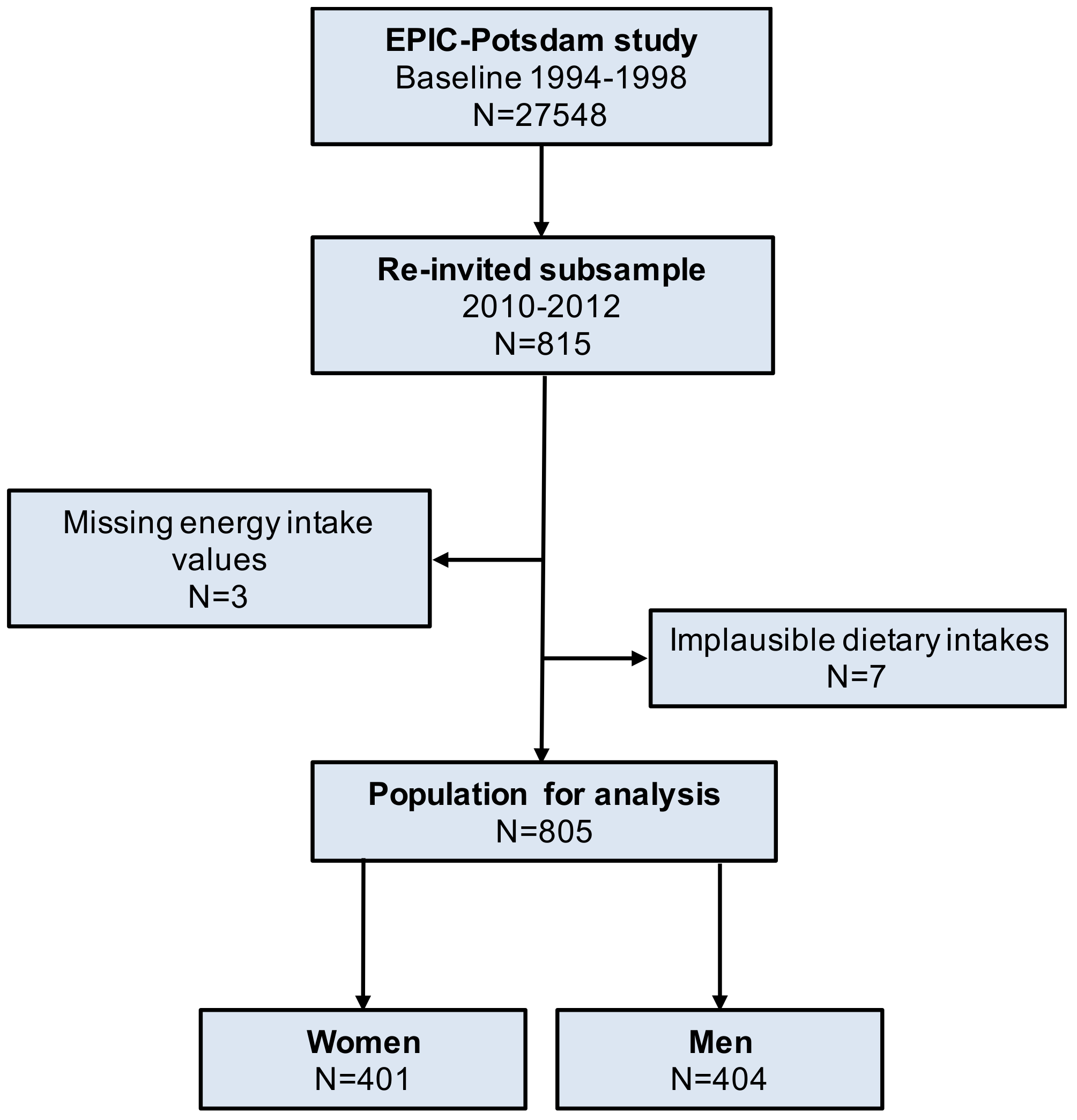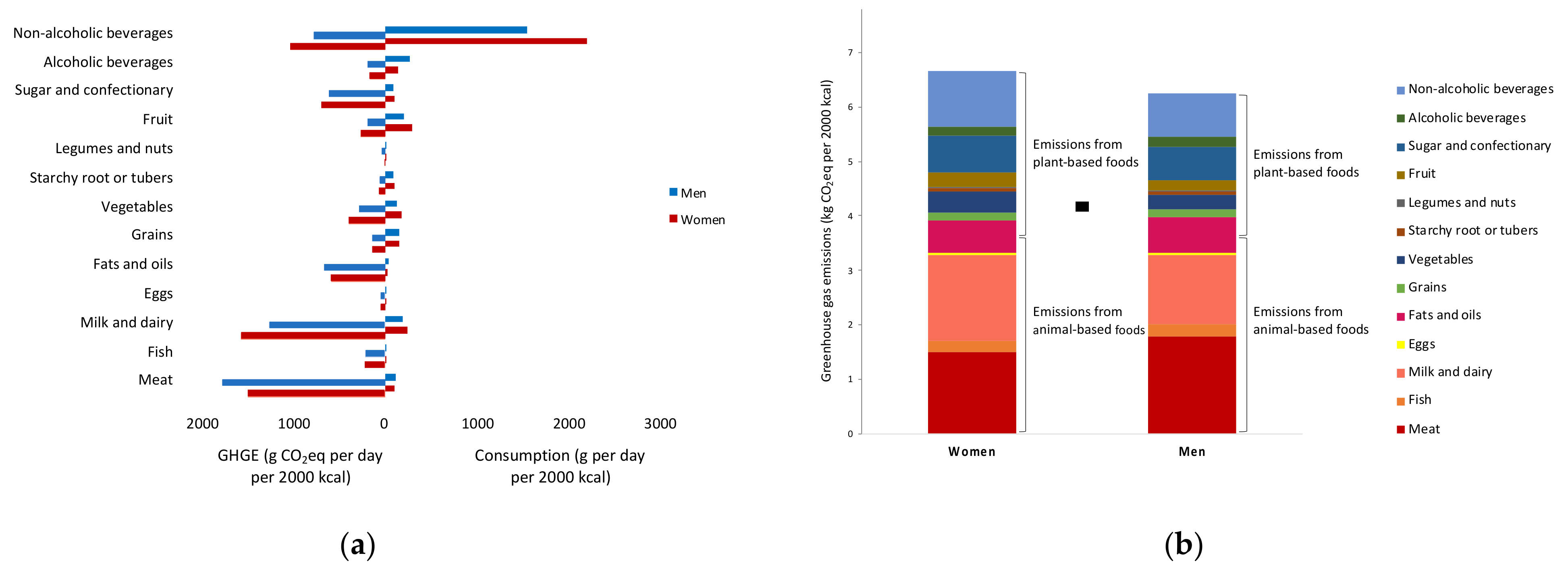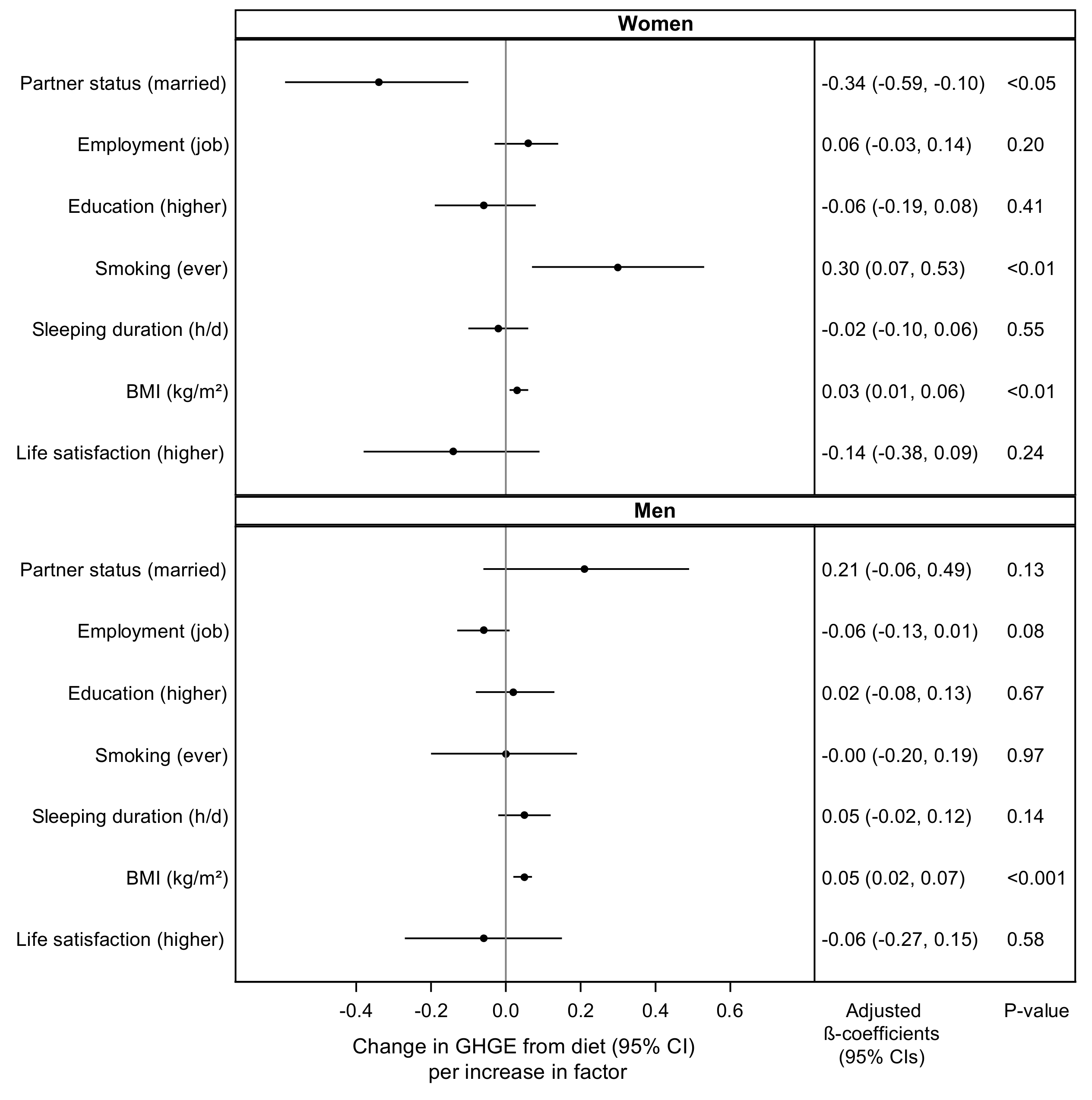Dietary Choices Impact on Greenhouse Gas Emissions: Determinants and Correlates in a Sample of Adults from Eastern Germany
Abstract
1. Introduction
2. Materials and Methods
2.1. Study Population
2.2. Data Collection
2.3. Environmental Indicators
2.4. Statistical Analysis
3. Results
4. Discussion
5. Conclusions
Supplementary Materials
Author Contributions
Funding
Institutional Review Board Statement
Informed Consent Statement
Data Availability Statement
Acknowledgments
Conflicts of Interest
References
- Shukla, P.R.; Skea, J.; Buendia, E.C.; Masson-Delmotte, V.; Pörtner, H.-O.; Roberts, D.C.; Zhai, P.; Slade, R.; Connors, S.; Diemen, R.V.; et al. Climate Change and Land: An IPCC Special Report on Climate Change, Desertification, Land Degradation, Sustainable Land Management, Food Security, and Greenhouse Gas Fluxes in Terrestrial Ecosystems; IPCC: Geneva, Switzerland, 2019. [Google Scholar]
- Foley, J.A.; Ramankutty, N.; Brauman, K.A.; Cassidy, E.S.; Gerber, J.S.; Johnston, M.; Mueller, N.D.; O’Connell, C.; Ray, D.K.; West, P.C.; et al. Solutions for a cultivated planet. Nature 2011, 478, 337–342. [Google Scholar] [CrossRef] [PubMed]
- Popkin, B.M.; Adair, L.S.; Ng, S.W. Global nutrition transition and the pandemic of obesity in developing countries. Nutr. Rev. 2012, 70, 3–21. [Google Scholar] [CrossRef] [PubMed]
- Tilman, D.; Clark, M. Global diets link environmental sustainability and human health. Nature 2014, 515, 518–522. [Google Scholar] [CrossRef] [PubMed]
- Willett, W.; Rockström, J.; Loken, B.; Springmann, M.; Lang, T.; Vermeulen, S.; Garnett, T.; Tilman, D.; DeClerck, F.; Wood, A.; et al. Food in the Anthropocene: The EAT—Lancet Commission on healthy diets from sustainable food systems. Lancet 2019, 393, 447–492, Erratum in Lancet 2019. [Google Scholar] [CrossRef]
- Burlingame, B.; Dernini, S. Sustainable Diets and Biodiversity; Food and Agriculture Organization of the United Nations, Bioversity International: Rome, Italy, 2012. [Google Scholar]
- BMEL. Statistisches Jahrbuch über Ernährung, Landwirtschaft und Forsten der Bundesrepublik Deutschland, 61. Jahrgang; Bundesinformationcentrum: Landwirtshaft, Germany, 2017; pp. 146–152. [Google Scholar]
- OECD. Meat Consumption (Indicator); Organisation for Economic Cooperation and Development: Paris, France, 2020. [Google Scholar] [CrossRef]
- Umwelt Bundesamt. Treibhausgasminderungsziele Deutschlands. Available online: https://www.umweltbundesamt.de/daten/klima/treibhausgasminderungsziele-deutschlands#internationale-vereinbarungen-weisen-den-weg (accessed on 20 November 2021).
- Kolbe, K. Mitigating climate change through diet choice: Costs and CO2 emissions of different cookery book-based dietary options in Germany. Adv. Clim. Chang. Res. 2020, 11, 392–400. [Google Scholar] [CrossRef]
- Fritsche, U.R.; Eberle, U. Treibhausgasemissionen durch Erzeugung und Verarbeitung von Lebensmitteln: Arbeitspapier; Nahrungsmittel-Klima; Öko-Institut e.V.: Darmstadt, Germany, 2007. [Google Scholar] [CrossRef]
- Meier, T.; Christen, O. Gender as a factor in an environmental assessment of the consumption of animal and plant-based foods in Germany. Int. J. Life Cycle Assess. 2012, 17, 550–564. [Google Scholar] [CrossRef]
- Meier, T.; Christen, O. Umweltwirkungen der Ernährung: Ökobilanzierung des Nahrungsmittelverbrauchs tierischer Produkte nach Gesellschaftsgruppen in Deutschland. In Proceedings of the Beitrag zur Jahrestagung der Gesellschaft für Wirtschafts-und Sozialwissenschaften des Landbaus (GEWISOLA), Halle, Germany, 28–30 September 2011. [Google Scholar]
- Reinhardt, G.; Gärtner, S.; Münch, J.; Häfele, S. Ökologische Optimierung Regional Erzeugter Lebensmittel: Energie- und Klimabilanzen; IFEU: Heidelberg, Germany, 2009. [Google Scholar]
- Taylor, C. Ökologische Bewertung von Ernährungsweisen Anhand Ausgewählter Indikatoren. Master’s Thesis, Justus-Liebig-Universität, Gießen, Germany, 2000. [Google Scholar]
- Prütz, F.; Rommel, A.; Kroll, L.E.; Lampert, T. 25 Years after the Fall of the Berlin Wall: Regional Differences in Health; Robert Koch Institut: Berlin, Germany, 2014; Volume 5, p. 13. [Google Scholar] [CrossRef]
- Mensink, G.B.M.; Beitz, R. Food and nutrient intake in East and West Germany, 8 years after the reunification—The German Nutrition Survey 1998. Eur. J. Clin. Nutr. 2004, 58, 1000–1010. [Google Scholar] [CrossRef]
- Vogt, T.; Van Raalte, A.; Grigoriev, P.; Myrskylä, M. The German East-West Mortality Difference: Two Crossovers Driven by Smoking. Demography 2017, 54, 1051–1071. [Google Scholar] [CrossRef]
- Riboli, E.; Hunt, K.J.; Slimani, N.; Ferraria, P.; Norata, T.; Fahey, M.; Charrondierea, U.R.; Hemona, B.; Casagrandea, C.; Vignata, J.; et al. European Prospective Investigation into Cancer and Nutrition (EPIC): Study populations and data collection. Public Heal. Nutr. 2002, 5, 1113–1124. [Google Scholar] [CrossRef]
- Boeing, H.; Wahrendorf, J.; Becker, N. EPIC-Germany—A source for studies into diet and risk of chronic diseases. European Investigation into Cancer and Nutrition. Ann. Nutr. Metab. 1999, 43, 195–204. [Google Scholar] [CrossRef]
- Bohlscheid-Thomas, S.; Hoting, I.; Boeing, H.; Wahrendorf, J. Reproducibility and relative validity of energy and macronutrient intake of a food frequency questionnaire developed for the German part of the EPIC project. European Prospective Investigation into Cancer and Nutrition. Int. J. Epidemiol. 1997, 26 (Suppl. 1), 71–81. [Google Scholar] [CrossRef]
- Mertens, E.; Kaptijn, G.; Kuijsten, A.; van Zanten, H.; Geleijnse, J.M.; Veer, P.V.‘t. SHARP-Indicators Database towards a public database for environmental sustainability. Data Brief 2019, 27, 104617. [Google Scholar] [CrossRef]
- Vellinga, R.E.; Van De Kamp, M.; Toxopeus, I.B.; Van Rossum, C.T.M.; De Valk, E.; Biesbroek, S.; Hollander, A.; Temme, E.H.M. Greenhouse Gas Emissions and Blue Water Use of Dutch Diets and Its Association with Health. Sustainability 2019, 11, 6027. [Google Scholar] [CrossRef]
- Liang, L.; Ridoutt, B.; Wang, L.; Xie, B.; Li, M.; Li, Z. China’s Tea Industry: Net Greenhouse Gas Emissions and Mitigation Potential. Agriculture 2021, 11, 363. [Google Scholar] [CrossRef]
- Taylor, A.E.; Richmond, R.C.; Palviainen, T.; Loukola, A.; Wootton, R.E.; Kaprio, J.; Relton, C.L.; Smith, G.D.; Munafò, M.R. The effect of body mass index on smoking behaviour and nicotine metabolism: A Mendelian randomization study. Hum. Mol. Genet. 2018, 28, 1322–1330. [Google Scholar] [CrossRef]
- Spencer, E.A.; Appleby, P.N.; Davey, G.K.; Key, T.J. Diet and body mass index in 38 000 EPIC-Oxford meat-eaters, fish-eaters, vegetarians and vegans. Int. J. Obes. 2003, 27, 728–734. [Google Scholar] [CrossRef]
- Hasan, M.M. Does Consumer Behaviour on Meat Consumption Increase Obesity?—Empirical Evidence from European Countries. Int. J. Econ. Behav. Organ. 2014, 2, 1–5. [Google Scholar] [CrossRef][Green Version]
- Tucker, L.A.; Tucker, J.; Bailey, B.; LeCheminant, J.D. Meat Intake Increases Risk of Weight Gain in Women: A Prospective Cohort Investigation. Am. J. Heal. Promot. 2014, 29, e43–e52. [Google Scholar] [CrossRef]
- Fricker, J.; Baelde, D.; Igoin-Apfelbaum, L.; Huet, J.-M.; Apfelbaum, M. Underreporting of food intake in obese “small eaters”. Appetite 1992, 19, 273–283. [Google Scholar] [CrossRef]
- Sugimoto, M.; Murakami, K.; Asakura, K.; Masayasu, S.; Sasaki, S. Diet-related greenhouse gas emissions and major food contributors among Japanese adults: Comparison of different calculation methods. Public Health Nutr. 2020, 24, 973–983. [Google Scholar] [CrossRef]
- Vieux, F.; Perignon, M.; Gazan, R.; Darmon, N. Dietary changes needed to improve diet sustainability: Are they similar across Europe? Eur. J. Clin. Nutr. 2018, 72, 951–960. [Google Scholar] [CrossRef]



| Quartile 1 | Quartile 2 | Quartile 3 | Quartile 4 | ||
|---|---|---|---|---|---|
| n = 202 | n = 200 | n = 202 | n = 201 | ||
| Total greenhouse gas emissions from diet [kgCO2 eq per 2000 kcal], mean (SD) | 5.6 (0.5) | 6.4 (0.2) | 7.0 (0.2) | 8.2 (0.7) | |
| Socio-demographic factors | |||||
| Age | Age [years], mean (SD) | 64.9 (8.2) | 66.0 (8.2) | 66.8 (8.3) | 66.1 (8.4) |
| Sex | Female, n (%) | 79 (39.1) | 85 (42.5) | 109 (54.0) | 128 (63.7) |
| Partner status | Single, n (%) | 33 (16.3) | 31 (15.5) | 43 (21.3) | 56 (27.9) |
| Employment | Unemployed, n (%) | 117 (57.9) | 124 (62.0) | 137 (67.8) | 126 (62.7) |
| Education | University degree, n (%) | 103 (51.0) | 87 (43.5) | 81 (40.1) | 86 (42.8) |
| Lifestyle factors | |||||
| Smoking | Current smoker, n (%) | 23 (11.4) | 13 (6.5) | 21 (10.4) | 26 (12.9) |
| Past smoker, n (%) | 89 (44.1) | 82 (41.0) | 88 (43.6) | 86 (42.8) | |
| Non-smoker, n (%) | 90 (44.5) | 105 (52.5) | 93 (46.0) | 89 (44.3) | |
| Sleep | Sleeping duration [h/24 h], median (IQR) | 7.5 (7.0, 8.2) | 7.5 (7.0, 8.3) | 7.6 (7.0, 8.5) | 8.0 (7.0, 8.2) |
| Physical activity | Recreational sports [h/w], median (IQR) | 1.5 (0.0, 3.0) | 2.0 (1.0, 3.3) | 2.0 (1.0, 3.0) | 2.0 (0.5, 3.5) |
| Gardening [h/w], median (IQR) | 3.0 (0.5, 7.5) | 3.3 (1.0, 6.0) | 3.0 (0.5, 7.0) | 3.0 (0.5, 6.0) | |
| Cycling [h/w], median (IQR) | 1.5 (0.0, 4.0) | 2.5 (0.5, 5.0) | 1.5 (0.0, 3.5) | 1.5 (0.0, 4.5) | |
| Obesity | BMI ≥ 30 kg/m2, n (%) | 35 (17.3) | 46 (23.0) | 45 (22.3) | 64 (31.8) |
| Wellbeing-related factors | |||||
| Chronic stress | Hair cortisol [pg/mg], median (IQR) | 28.7 (17.2, 43.4) | 26.3 (16.2, 43.2) | 27.0 (17.3, 49.5) | 27.8 (16.6, 50.4) |
| Self-reported wellbeing | Health satisfaction—Satisfied, n (%) | 164 (81.2) | 157 (78.5) | 170 (84.2) | 164 (81.6) |
| Life satisfaction—Satisfied, n (%) | 149 (73.8) | 142 (71.0) | 149 (73.8) | 137 (68.2) | |
Publisher’s Note: MDPI stays neutral with regard to jurisdictional claims in published maps and institutional affiliations. |
© 2022 by the authors. Licensee MDPI, Basel, Switzerland. This article is an open access article distributed under the terms and conditions of the Creative Commons Attribution (CC BY) license (https://creativecommons.org/licenses/by/4.0/).
Share and Cite
Koelman, L.; Huybrechts, I.; Biesbroek, S.; van ‘t Veer, P.; Schulze, M.B.; Aleksandrova, K. Dietary Choices Impact on Greenhouse Gas Emissions: Determinants and Correlates in a Sample of Adults from Eastern Germany. Sustainability 2022, 14, 3854. https://doi.org/10.3390/su14073854
Koelman L, Huybrechts I, Biesbroek S, van ‘t Veer P, Schulze MB, Aleksandrova K. Dietary Choices Impact on Greenhouse Gas Emissions: Determinants and Correlates in a Sample of Adults from Eastern Germany. Sustainability. 2022; 14(7):3854. https://doi.org/10.3390/su14073854
Chicago/Turabian StyleKoelman, Liselot, Inge Huybrechts, Sander Biesbroek, Pieter van ‘t Veer, Matthias B. Schulze, and Krasimira Aleksandrova. 2022. "Dietary Choices Impact on Greenhouse Gas Emissions: Determinants and Correlates in a Sample of Adults from Eastern Germany" Sustainability 14, no. 7: 3854. https://doi.org/10.3390/su14073854
APA StyleKoelman, L., Huybrechts, I., Biesbroek, S., van ‘t Veer, P., Schulze, M. B., & Aleksandrova, K. (2022). Dietary Choices Impact on Greenhouse Gas Emissions: Determinants and Correlates in a Sample of Adults from Eastern Germany. Sustainability, 14(7), 3854. https://doi.org/10.3390/su14073854






